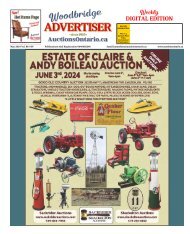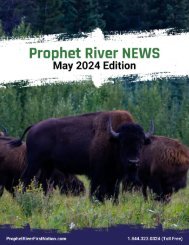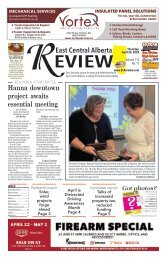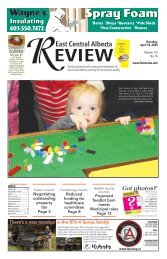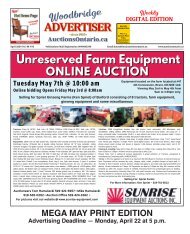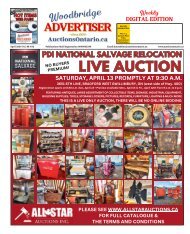Woodbridge Advertiser/AuctionLists.ca - 2021-12-22
Woodbridge Advertiser/AuctionLists.ca - 2021-12-22
Woodbridge Advertiser/AuctionLists.ca - 2021-12-22
You also want an ePaper? Increase the reach of your titles
YUMPU automatically turns print PDFs into web optimized ePapers that Google loves.
CURRENT JANUARY 20<strong>22</strong> THE WOODBRIDGE ADVERTISER PAGE SEVENTEEN<br />
Muskoka‘s Ghost Towns<br />
Most ghost town hunters seem to know the popular Muskoka ghost towns<br />
like: Germania, Uffington, Falkenburg, Cooper's Falls and to a lesser<br />
extent: Monsell and Lewisham. But there are others. Thanks to the book by<br />
Hind and DaSilva, "Ghost Towns of Muskoka", these hamlets have been<br />
brought back to memory. Here are some short bios on each..<br />
ROSSEAU FALLS — Founded on the north shore of Lake Rosseau by Peter<br />
Mutchenbacker, a pioneer from Germany, in 1877. At the mouth of the<br />
Rousseau River he built a saw and shingle mill by harnessing the power of<br />
the falls. Later he had a steam-operated outfit, which meant for a longer<br />
cutting season. There were <strong>ca</strong>bins built for the families and the mill workers.<br />
Peter's home was first made of logs, but his second home was the centrepiece<br />
of the hamlet where he opened a post office and store in 1880.<br />
There were no roads and communi<strong>ca</strong>tion was done by a mail ship. The trees<br />
were depleted by 1928 and the community went into decline. There are remnants<br />
in the bay to this day of the mill. Take Hwy 141 to Rosseau Rd 3 and<br />
drive south to the falls.<br />
DEE BANK — Another short-lived pioneer crossroads milltown. John<br />
Shannon bought land here in 1868 where the Dee River rushes into Three<br />
Mile Lake. Here he built a grist mill. Due to its strategic lo<strong>ca</strong>tion the community<br />
grew to inlcude 2 hotels alongside the bush farms. It was the largest<br />
village in Watt Township. The store and post office was run by John Barber;<br />
there was a tannery, blacksmith, church, school and pop. of 75. It was hit<br />
by two major blows- be<strong>ca</strong>use it was inland the new steamships to<br />
Windermere past it by and the railway bypassed it. Only the school<br />
remains. Take Hwy 141 to Deebank Rd. and head south to the Dee River.<br />
According to friend and fellow Ontario history buff, Gary Long, "Dee Bank<br />
was just a small mill village with a few residences, a school, a store, and of<br />
course the mills. I found a bit of the gristmill foundation on the south side<br />
of the river at the bottom of the falls, and on the north side, the barely discernible<br />
route of the road that formerly crossed a bridge at the top of the<br />
falls and angled up the hillside. The authors of the book might have found<br />
additional foundations, etc. I'm sure if you looked around hard enough in<br />
the woods near the falls, you'd find other remains, though not necessarily<br />
dating back as far as the original village.<br />
Lo<strong>ca</strong>tions of towns weren't always logi<strong>ca</strong>l in terms of terrain. Look at<br />
Bracebridge and Huntsville, the original sections piled on hills when there<br />
was plenty of flat land nearby. Usually the early growth took place closest to<br />
the feature that resulted in the settlement being there. In the <strong>ca</strong>se of<br />
Bracebridge and Dee Bank, that was the falls with its mills, and it's usually<br />
rocky and hilly close to falls."<br />
MILLAR HILL — Considered the high north country when nobody lived<br />
this far north in Muskoka. Here David Millar decided to give bush farming<br />
a whirl in the 1870s. As the trees were removed others joined the settlement<br />
on the hardest terrain imaginable. Joseph Langmeade founded a school,<br />
church and the post office (19<strong>12</strong>-1930). Fred Quinn built a sawmill on the<br />
Boyne R. which brought a boost to the growing community, but later the<br />
sawmill moved to Dwight and Millar Hill went into dire straits. Take Hwy.<br />
60 to Millar Hill Rd. and drive to the end. Foundations <strong>ca</strong>n be found on the<br />
observatory road before u get up to the summit where the radio towers are.<br />
SELDOM SEEN — Founded in the 1870s in an isolated corner of Ma<strong>ca</strong>ulay<br />
Township, south of Fawn Lake, it didn't live long. It got its name as a joke,<br />
meaning they were so far from civilization and the outside world. William<br />
Dennis was the councillor and Alfred Lee was a farmer, teacher and assessor.<br />
There was a store, small sawmill and school. In 1886 the township<br />
moved the school miles away and the villagers were very upset. They rebuilt<br />
another in its place to the dismay of the township. The school closed in<br />
19<strong>12</strong> as the villagers could no longer handle the conditions of their land.<br />
BEATTY'S SIDING — 3 km. west of Swords on the famed Booth railway<br />
was its lo<strong>ca</strong>tion. Here, 20 plus trains per day passed by. The railway<br />
housed rail workers here and a village formed with both farmers and loggers<br />
in 1894. The Ludgate Lumber Co. was the main outfit. The children<br />
went to school in Swords. Ludgate Co. moved out in 1910 and train traffic<br />
dwindled, as did the town.<br />
JERUSALEM — A true ghost town as it is hard to find even in the history<br />
books. The short-lived hamlet was founded in 1866 by Thomas Peacock<br />
deep in a forested valley on a north branch of the Muskoka River. As the<br />
land was painstakingly cleared for crops, 8 buildings were erected; but it is<br />
not known if they were part of a village or of a homestead or two. It was situated<br />
between High Falls Rd., Hwy. 11 and Falkenburg Rd.<br />
BEAR LAKE — Norwegians <strong>ca</strong>me to Canada by the 1000's. Some <strong>ca</strong>me to<br />
Muskoka and settled at Bear Lake in the 1880's. They were offered free land<br />
if they cleared it and worked at the lumber mills. They <strong>ca</strong>lled their settlement<br />
Jarlsberg, and it had a mill, school, store, post office, church and<br />
blacksmith. By 1893 the name was changed to Bear Lake. Only their St.<br />
Olaf's Church, pillars and 2 old buildings remain to this day. Take Hwy.<br />
518 to Bear Lake, east of the Nipissing Colonization Rd.<br />
HOODSTOWN —On the north shore of Lake Vernon a village formed that<br />
was meant to be a major hub for Muskoka. Railways were being built<br />
throughout the rugged terrain. Charles and Janet Hood had a vision and<br />
bought a lot of land as a speculation that 2 major railway lines would one<br />
day meet up at this spot where a small river joined Lake Vernon and Fox<br />
Lake. They <strong>ca</strong>me from Toronto as they had heard of the boom in Muskoka.<br />
Things looked promising in 1877, and by 1889 the Hoods had made a townplan<br />
with 276 lots on 9 streets. There were 3 stores, 3 churches, a post<br />
office, a sawmill, a hotel, a blacksmith and homes. But their speculation<br />
never paid off as the railways bypassed the area. The post office shut down<br />
in 1892 and the townsfolk moved to Hunstville.<br />
EMBERSON — Was the most obscure ghost town of Muskoka during its<br />
brief life. Even written accounts seem to be rumoured memories. But it did<br />
exist. In 1876 on one of Brunel Township's windy, swampy, rocky, treeinfested<br />
roads a community was formed. Henry Jarvis opened the post<br />
office the same year. The children had to travel a distance to school in the<br />
next township over. By 1900 there were 60 brave souls within its confines.<br />
The bush farms and logging <strong>ca</strong>mps lasted until 1910 and its post office<br />
until 1924. Stone foundations exist, though the area has long since been<br />
swallowed up by the forest According to Hinds and Brown it lies 2 km.<br />
north of Muskoka Rd. 11 and 2 km. east of Muskoka Rd. 7. But these directions<br />
make no sense logi<strong>ca</strong>lly. I found an old map that shows Emberson<br />
and it was lo<strong>ca</strong>ted north of Britannia Rd (Cty Rd 10) and west of South<br />
Portage Rd. (Cty Rd 9), which is now a huge forest. Got its post office in<br />
1874. Emberson wasn't really even a village, just a rural post office serving<br />
the farm families in that section. Never had a school or any businesses<br />
other than farms. The section of road that went through Emberson hasn't<br />
been open for many years, though you <strong>ca</strong>n still walk it or mountain bike it.<br />
SOUTH PORTAGE — Is a semi-ghost town mentioned in one of Ron<br />
Brown's books. Lo<strong>ca</strong>ted on the north shore of Lake of Bays it once was<br />
home to the shortest commercial railway line in the world, <strong>ca</strong>lled the<br />
Portage Railway. Its train, <strong>ca</strong>lled "The Portage Flyer", ran less than 2 kms,<br />
and ferried passengers between North Portage on Peninsula Lake and<br />
South Portage in the early 1900's. It lasted until 1958.<br />
The Portage Flyer<br />
Visit www.ontarioabandonedplaces.com!








